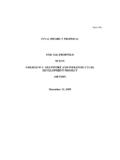Transcription of ZAMBIA - OECD.org
1 ZambiaLusakakey figures Land area, thousands of km2753 Population, thousands (2001) 10 649 GDP per capita, $ (2001)339 Life expectancy (2000-2005) Illiteracy rate (2001) Economic Outlook AfDB/OECD 2003337IN1991 ZAMBIA STARTED A RADICAL reform path thattransformed it from a centrally planned to a marketeconomy. This dramatic change, which entailedprivatising the initial close-to-80 per cent share ofpublic economic activity and liberalising prices formost commodities, revived the economy and resultedin a good growth performance for the first half of the1990s. Nevertheless, the government has not been verysuccessful in diversifying the country s export base awayfrom its heavy dependency on copper, or managing itsexpenditures more efficiently, whose funding stillstrongly rely on foreign assistance, or, and mostimportantly, reducing poverty.
2 These shortcomingsoriginate mainly from delays in the implementation ofstructural reforms. Economic performance improvedsignificantly in 2001 GDP grew by percent thanks to the recent investments inthe privatised copper sector. Howeverimportant tests await the new government,elected in December 2001: the pull out ofthe Anglo-American Corporation (the majorprivate shareholder in the largest miningImproving economicgovernance and diversifying away from mining havebecome Zambian priorities-10-8-6-4-202468102003 (p)2002(e)2001200019991998199719961995 Figure 1- Real GDP GrowthSource:Authors estimates and predictions based on Central Statistical Office in the country) may result in severe economicdisruption. Output of the main staple crop, maize, hasbeen meagre, following the massive drought that hitthe country in 2002, and its forecasts are notencouraging.
3 Crucial foreign aid ever more dependson domestic good governance; the aids pandemic is notdeclining while its devastating effects have not yet fullymaterialised. Growth for 2002 and 2003 is thereforeexpected to be below target at about and percent, respectively. The government medium-termstrategy for growth and poverty reduction is outlinedby the Poverty Reduction Strategy, issued in May 2002,which sets macroeconomic targets and policy actionsin order to reduce poverty and promote thediversification away from mining. In support of ZAMBIA scommitment to the economic programme, at theConsultative Donor meeting held in July 2002, thedonor community pledged about $ billion for 2003and Economic DevelopmentsZambia s recent economic performance suffers froma mix of domestic and international unfavourablefactors.
4 On the domestic side, the governmentAfrican Economic Outlook AfDB/OECD 2003338 Zambiaprivatisation strategy has been hesitant when dealingwith some crucial sectors (particularly those consideredstrategic institutions): copper mining was privatisedonly in March 2000, and the energy, telecom, andfinancial sectors are still to be privatised. Inefficient andunder-capitalised SOEs in these sectors have keptgenerating losses, which, together with the 2001presidential elections and the Organisation of AfricanUnity (OAU) summit s exceptional expenditures, createdserious budget problems for the Zambian external factors such as lower copper prices, theshrinking of foreign budget support, and regionaltensions (Angola, Congo and recently Zimbabwe),have worsened the situation and further limited thegovernment resources to stimulate economic growth,even if the external debt burden has been significantlyreduced on account of the Heavily Indebted PoorCountry (HIPC) initiative.
5 In spite of good GDPgrowth in 1996 (which was over 6 per cent followinga good harvest) growth in the rest of the 1990s was eithernegative or slightly positive. In contrast with this gloomypicture, real GDP grew by per cent in 2001, owingmainly to an increase in the mining production fuelledby improved efficiency of the privatised though, forecasts for 2002 and 2003 arenot as favourable as hoped: in particular the pull outof Anglo-American Corporation and the massivedrought that hit the country in 2002 have determineda 2002 GDP growth of per cent. In 2003 growthis forecast at per most urgent issue for the Zambian economyis thus a further reduction of its dependency on copperand the encouragement of private sector investmentinto export oriented agriculture, light manufacturing,small scale mining and tourism.
6 In this light,diversification programmes and dialogue with supportfrom the World Bank have commenced with a seriesof consultative workshops, particularly with theCopperbelt business community, which is largelydependent on the mining sector. ZAMBIA is well endowed with mineral resources andthe country derives most of its foreign earnings fromthe export of minerals. The mining industry, whichis dominated by copper and a few other minerals,namely, zinc, silver, gold and cobalt, has been the mostimportant driving force of economic development inZambia for over 70 years. However, owing to decreasingworld prices in copper, poor investments in new andexisting mines and unsupportive management practices,copper production has declined and its contributionto the sector on GDP has progressively diminished,from 19 per cent in 1992 to around 4 per cent since1999.
7 However, in 2001, the sector recorded a realgrowth of 14 per cent compared to a growth of per cent in 2000 and a decline of per cent in1999. The rebound of the mining sector was mainlydue to a recovery in copper and cobalt production,arising from recapitalisation and investment activities,following privatisation of the mines in 2000. However, Africa Zambia0100200300400500600700800900200120 0019991998199719961995199419931992199119 90 Figure 2- GDP Per Capita in ZAMBIA and in Africa ($ current)Source:Authors estimates based on Economic Outlook AfDB/OECD 2003339 ZAMBIA Value Price Volume-505101520253035 Gross value added at basic pricesOther services Government servicesTransport, Storage and CommunicationsRestaurants, Bars and HotelsWholesale and Retail tradeConstructionElectricity, Gas and WaterManufacturingMining and QuarryingAgriculture, Forestry and FishingFigure 4- Sectoral Contribution to GDP Growth in 2001 Source.
8 Authors estimates based on Central Statistical Office servicesAgriculture, Forestry and FishingMining and quarryingManufacturingElectricity, Gas and WaterConstructionWholesale andretail tradeRestaurants, Bars and HotelsTransport, storage and communicationsGovernment services20%4%4%6%11%19%3%7%17%9%Figure 3- GDP by Sector in 2001 Source:Authors estimates based on Central Statistical Office are increasing uncertainties about the prospectsof the mining sector, following the decision (January2002) of the major shareholder in the largest miningcompany, the Konkola Copper Mines (KCM) towithdraw from the company and its exit in August20021. KCM s investment plans have been reducedand its output is estimated to contract. The outlookfor production remains therefore uncertain, dependingmainly on the performance of the smaller coppermining firms.
9 The dominant position of copper miningin the economy has largely overshadowed theexploitation of other potential mineral resources,1. The structural section provides a detailed illustration of the privatisation process and current situation of the mining Economic Outlook AfDB/OECD 2003340 Zambiaparticularly in the field of gemstone and industrialmineral, which offer great potential. Agriculture, fishery and forestry, which accountfor 20 per cent of Zambian GDP, shrunk by percent in 2001. Compared to many other SouthernAfrican countries, ZAMBIA has relatively abundant landand water. Some of 58 per cent of ZAMBIA s total landarea is considered as medium to high potential foragricultural production, however, only 14 per cent ofZambia s total agricultural land is currently beingcultivated.
10 The unused potential and the sector s highdependence on seasonal rainfall lead to a highly variableperformance and very often food security is notguaranteed. In the 2000/01 crop season, agricultureunder performed owing to scanty rains in most partsof the country at the beginning of the season, followedby excess of rainfall in some areas, and prolonged dryspells in the southern regions. The national productionof maize, which is the main food crop, decreased byabout 30 per cent compared to the 1999/2000 cropseason (from 1 053 000 to 802 000 metric tonnes). Thesituation deteriorated even further in the followingcrop season since drought in early 2002 led to a maizeshortage of 635 000 metric tonnes. It is estimated thatthe 2001/02 crop production will only feed 6 millionpeople out of a total population of more than 10 May 2002, as a consequence of massive drought, theZambian government declared a national disaster withregard to food insecurity and water shortage in thesouthern province and asked for urgent donor order to cope with this emergency, the World FoodProgramme (WFP) and many donors became involvedin food aid programs.















